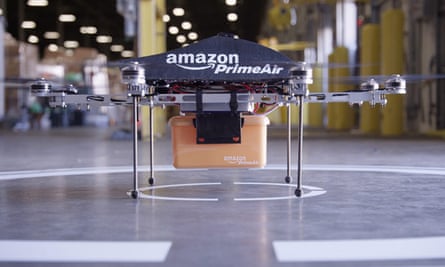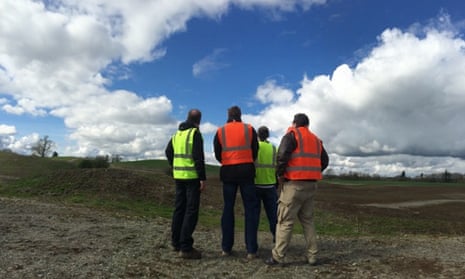Amazon is testing its drone delivery service at a secret site in Canada, following repeated warnings by the e-commerce giant that it would go outside the US to bypass what it sees as the US federal government’s lethargic approach to the new technology.
The largest internet retailer in the world is keeping the location of its new test site closely guarded. What can be revealed is that the company’s formidable team of roboticists, software engineers, aeronautics experts and pioneers in remote sensing – including a former Nasa astronaut and the designer of the wingtip of the Boeing 787 – are now operating in British Columbia.
The end goal is to utilise what Amazon sees as a slice of virgin airspace – above 200ft, where most buildings end, and below 500ft, where general aviation begins. Into that aerial slice the company plans to pour highly autonomous drones of less than 55lbs, flying through corridors 10 miles or longer at 50mph and carrying payloads of up to 5lbs that account for 86% of all the company’s packages.
Amazon has acquired a plot of open land lined by oak trees and firs, where it is conducting frequent experimental flights with the full blessing of the Canadian government. As if to underline the significance of the move, the test site is barely 2,000ft from the US border, which was clearly visible from where the Guardian stood on a recent visit.
The Guardian was invited to visit Amazon’s previously undisclosed Canadian drone test site, where it has been conducting outdoor flights for the past few months. For the duration of the visit, three plain-clothed security guards kept watch from the surrounding hills.
Amazon’s drone visionaries are taking the permissive culture on the Canadian side of the border and using it to fine-tune the essential features of what they hope will become a successful delivery-by-drone system. The Guardian witnessed tests of a hybrid drone that can take off and land vertically as well as fly horizontally.
The company’s decision to set up camp in Canada, after frustration in its attempts to persuade US regulators to allow it to launch its drones in Washington state, takes Amazon’s quarrel with the federal government to a new level. Last week a senior Amazon executive appeared before a US Senate subcommittee and warned that there would be consequences if federal regulators continued to act as a drag on its ambitions to launch a drone delivery service called Prime Air.
What Paul Misener, the company’s vice-president for global public policy, did not tell senators was that at the very moment he appeared before them, Amazon drones were buzzing in the skies just north of the border.
The company wants to offer its customers the ability to have packages dropped on their doorstep by flying robots within 30 minutes of ordering goods online. With innovation in the drone sector reaching lightning speeds, Amazon said it was not prepared to curtail its ambitions because of what Misener said was a lack of “impetus” on the US side of the border.
“We think that this new technology will provide huge benefits for our customers, who we think will love it, and for society more broadly,” he told the Guardian a day after the subcommittee hearing. “Why would we wait?”

Gur Kimchi, the architect and head of Prime Air, said the hope had always been to develop the drone service in the US, close to the company’s Seattle headquarters. “But we’re limited there to flying indoors and have been now for a very long time. So we do what’s necessary – we go to places where we can test outside, in this case Canada.”
Drone technology is seen by many tech companies and aeronautics experts as the next frontier for innovation, with billions of dollars potentially in the balance. Traditionally, the US has been at the vanguard of both tech and aviation innovation, but the approach of the the Federal Aviation Authority (FAA), a US regulatory body, has been markedly tentative so far compared with that of regulators in Canada and Europe.
Brendan Schulman, a New York-based specialist in drone law, said the Guardian’s disclosure of Amazon’s Canadian airstrip-in-exile should be a “serious wake-up call to politicians and regulators”.
“America has led the world in aviation development,” he said, “but for the first time in history we are at risk of losing out. To see one of our most innovative companies forced over the border is a stark example of the danger.”
Until it opened its Canadian base, Amazon had been limited to indoor testing in its Seattle laboratory, backed up with research outposts in the UK – in Cambridge – and Israel. Requests by the company to begin outdoor testing on company land in Washington state have so far largely been rebuffed by the FAA.
The federal agency recently published its guidelines for commercial use of small drones. The new rules will take at least two years to come into effect, a delay which Amazon finds unacceptable.
Last July, the company applied for a so-called 333 exemption that would allow it to carry out outdoor experimentation immediately. Eight months later, the FAA has not responded.
The federal body did agree last week, amid considerable fanfare, to award the company a so-called “experimental airworthiness certificate” that can be used to test a specific model of drone. But it took so long for the certificate to come through that by the time it was granted, Amazon said it was obsolete.
“The pace of innovation is so great at this point that our designs are changing very quickly,” Misener told the Guardian.
The contrast between the relative rigidity of the FAA’s approach to drone testing and the relatively relaxed regulatory regime in Canada is startling. Under the Canadian system, Amazon has been granted a virtual carte blanche regarding its entire fleet of drones within its designated airspace, having gone through a licensing process that took just three weeks.
By comparison, it takes the FAA many months to grant approval. Sources familiar with the process told the Guardian the US regulator insists on an initial 23-page application, a review of 75 pages of further documentation and a four-hour presentation at FAA headquarters followed by a three-hour site visit, together with ongoing reporting and record-keeping obligations.
Early experiments in Canada have focused on a range of individual drone capabilities: sensors that can detect and avoid obstacles in a drone’s path; link-loss procedures that control the aircraft should its connection with base be broken; stability in wind and turbulence; and environmental impact. Once each of these facets has been perfected, a new Amazon prototype drone will be assembled that Kimchi predicted would be utterly safe and wholly unlike anything seen before.
“We are going to end up with unique shapes, unique vehicles. The most important part is to develop strong confidence that our system is safe and that we can demonstrate that to customers,” he said.
“You can build a very different world. It can be faster, and safer, and more economic and more environmentally friendly – all of those things, all at the same time.”
FAA – a uniquely difficult job?

The FAA argues that the US has a uniquely difficult job in safeguarding the nation’s skies. It emphasises that it is responsible for the largest, most complex airspace in the world, which, unlike other countries’, is used by a large general aviation fleet.
“Different laws and regulatory structures in other nations may allow them to act more quickly to approve certain UAS [drone] operations,” an FAA spokesman told the Guardian. “Everything we do is safety-oriented, and we base our approvals for unmanned aircraft operations on an assessment of the risks to other aircraft and to people and property on the ground. We have been working diligently with Amazon to get the information we need.”
Misener said he respected the FAA’s desire to keep America’s airspace as safe as possible. “That’s our top priority in Amazon Prime Air too,” he said.
But he questioned the FAA’s portrayal of America’s unique position: “The US does have a complex airspace, but it’s no more complex than in Europe, where regulators do allow testing, and it’s certainly not complex beneath 500ft or in rural areas of Washington state where we had planned to operate.”
The numbers speak for themselves. The FAA has received more than 750 requests for outdoor drone testing licenses from American businesses, Amazon’s among them, but so far has granted just 48. Canada’s equivalent civil aviation authority, Transport Canada, released 1,672 commercial drone certificates last year alone.
Diana Cooper, head of drones and robotics at the Canadian law firm Labarge Weinstein, said that in recent months several US companies had contacted her to inquire about opportunities in her country – a phenomenon that she believes will be boosted further by Amazon’s decision to join the fold.
“Amazon will definitely be a trendsetter,” she said, “and will result in a lot of other large American companies like Google and Facebook looking at our market as well.”
Another battle is already on the horizon. The FAA has stated bluntly it does not believe that drones can be flown safely under their own autonomous control, and is insisting that humans must keep them within eyesight at all times. That is a deal-breaker for Amazon Prime Air, which could only function if drones were able to fly well beyond visual line of sight.
Here too, the contrast between the uncertainty of the US regulators and the can-do attitude of their Canadian and European equivalents is striking. A huge area of Alberta covering 700 square nautical miles of restricted airspace has already been set aside to allow for drones to be tested beyond visual line of sight. In Europe a similar facility is being opened in Wales.
Misener believes that with such opportunities exploding beyond US borders, it is only a matter of time before the FAA is forced to accept that drones are here to stay.
“This technology is going to work,” he said. “It’s coming.”

Comments (…)
Sign in or create your Guardian account to join the discussion